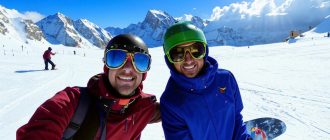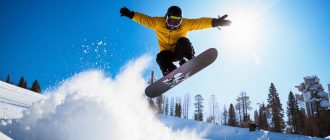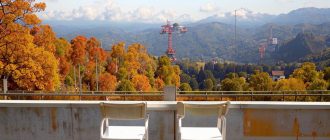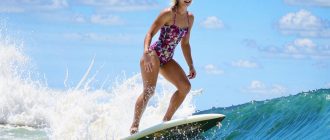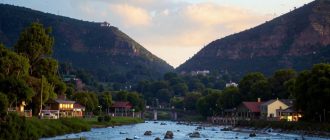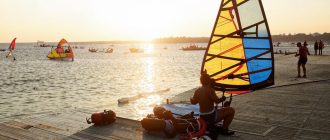
Sportmaster PRO expert
Before you can fully enjoy the pleasure of downhill skiing, you need to undergo a quick training. But don’t be frightened: at the first stage it is enough to master just a few skills, which will become the foundation for further progress.
The right stance
The correct stance refers to our position on the board, which helps us to perform our tasks (be it turns, braking, spins, etc.) as safely and easily as possible. The stance will change over time – just like level and preference (say carving and freestyle stances are different). But the base is always the same.
The first tryouts should be done standing still. Relax, stand on both feet (body weight is evenly distributed between the right and left), bend your knees a little (it is difficult and dangerous to skate on straight legs). Keep your back straight, there is no need to lean forward/backward – this will lead to loss of balance. Turn the body slightly in the direction of movement (not too much, we focus on the angle of the leading leg). Hands are not pressed, but held slightly to the side.
Turn your head in the direction of movement: many people have a habit of looking at the board while riding, so you need to get rid of it. A simple rule works: where we look, we go. If we look forward, we go forward, if we look down, we fall.
When practicing your stance, you should never hesitate to ask your instructor. This is the fastest and safest way to learn how to ride properly. If you don’t have such an opportunity, ask your friends to film your stance on their phones and then use the video to track your stance and skiing faults to work on correcting them.

Falls
Here we can make a small digression: most falls happen due to improper stance and skiing technique, and injuries happen due to lack of warm-up, protection and practice. That’s why it’s important not to neglect equipment, it minimizes damage from falls and makes you feel more confident.
In most cases we fall either backwards or face forward (in “skating” slang it is called “catching the front/back edge”).
If we fall on our back, we try to bend our legs as much as possible. The lower your body is during the fall, the less likely you are to suffer painful bruises and injuries. Hands backward should not be put out in any case, it is better to press them to the chest. The back should be rounded so that you do not fall on it, but roll like a ball. Finally, press your chin to your chest – this way your head will go higher and you will not hit the back of your head on the slope when falling.
If we fall forward, we also try to bend our knees as much as possible (as they account for the bulk of the impact), and put our arms out in front of us, bent at the elbows. Do not put forward straight arms – it is fraught with injuries. Bent arms will not stick into the slope, but will slip, which will avoid a strong impact and extinguish the inertia. It is better to turn your head to the side so that you do not stick your face into the snow.
If you have protection for your knees, elbows, tailbone, back and head, any fall will be much softer and result in fewer injuries.

Pivots
To start turning, you need to get a little familiar with the board. Choose a gentle section of the slope, insert the lead foot, put the other foot on the back edge. Keep the body weight on the front foot, push with the second foot and put it on the board in front of the rear binding. The body weight is on the front leg, the body is slightly turned to the side of the movement, the front arm is stretched over the nose of the board, the back arm is held over the knee of the unfastened leg, the back is straight, the head is looking in the direction of the movement.
In this way, we push off with the unbuckled leg, gain a little speed and put it on the snowboard, gradually getting used to the board and stance. If we start to turn, we shift a little more weight to the leading leg. It is important not to hurry, move smoothly, do not clamp and relax. The speeds are small: you can quietly practice moving forward.
When you can steadily go straight, we start to turn. On the back edge, the turn is made by pressing the heel of the leading foot (as if we were pushing the pedal in a car), and on the front edge – by pressing the toe of the shoe towards the front edge.

Braking
When the stance and falling skills are already practiced, we move on to the most important skill in skiing – braking.
Choose a slope with a slight incline, preferably not crowded – so as not to hit anyone and not to disturb anyone. You need to be able to stop or slow down both on the back and front edge. Therefore, it is worth practicing both variants.
Braking on the back edge. Stand across the slope with your knees slightly bent, arms stretched out in front of you and your gaze directed forward. Initially, all the weight is on the heels, the edge is pressed into the slope, and we do not move. If the toes of the boots are pushed down (“pedal down”), we will start sliding down. Don’t get scared and start moving down the slope, then pull the toes up (“pedal off”) and stop. It is important to watch your footwork and not to lower your toes too much, as you may catch the slope with your front edge and fall forward.
If during slipping the toes are already raised, but the forward movement does not stop, you need to squat lower, increasing pressure on the heels – and so on until the full stop.
Braking on the front edge. Knees are also bent, back straight, without moving forward or backward, arms stretched out in front of you. Slightly straighten your knees and slide down. To stop, bend your knees and press the toes of your boots into the slope.

Additional skills
You can add trampoline training to your snowboarding sessions – it will help you develop your coordination and work on different fall variations. It’s also a good warm-up and a way to improve stretching.
Besides, you need to train not only your body, but also your brain – that’s why it’s important to watch more training videos and get into the theory. This way you’ll progress faster and safer.
Any resort or town slope has slopes for beginners, and this is our choice. Wide and gentle, they are ideal for comfortable learning to ski.

Safety
All the basic information for comfortable and safe skiing is contained in the safety rules of each resort or slope.
The main thing is not to forget that there are other people in the place where you are skiing, and everyone has a different level of fitness. Before you start moving, it is important to make sure that you are not in anyone’s way.
If you need to stop, always move to the edge of the piste; before maneuvers – look at what is happening up the slope. If you stop, look up the slope behind you and don’t see anyone behind the bend, there is a high probability that those above you can’t see you either – it makes sense to change the place to a more visible one, so that another athlete will notice you in advance and correct your trajectory.

